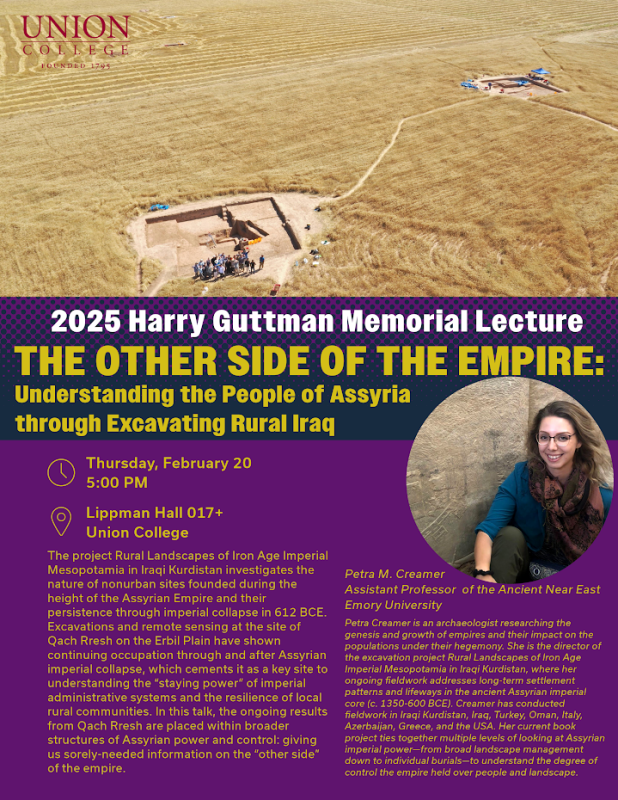The Classics Department is pleased to invite you to the 2025 Harry Guttman Memorial Lecture
The Other Side of the Empire: Understanding the People of Assyria through Excavating Rural Iraq
Petra Creamer, Emory University
Thursday, February 20
5:00 PM
Lippman Hall 017+
This year the Classics Departments' Annual Harry Guttman Memorial Lecture will be delivered by Petra Creamer, assistant professor of Middle Eastern Studies at Emory University. She will deliver a lecture entitled "The Other Side of the Empire: Understanding the People of Assyria through Excavating Rural Iraq" where she will guide us through her recent and ongoing archaeological fieldwork in rural Iraq (supported by a recent NSF grant and highlighted in Nature), providing insight into the lived experiences of the rural residents of the Assyrian Empire.
Lecture Abstract: As the largest polity the world had yet seen, stretching from Egypt to Iran at its height, the Assyrian Empire (c. 1350-612 BCE) provides a remarkable case study for assessing the effects of imperial power structures on those under their hegemony. However, studies have tended to prioritize the investigation of large cities, especially Assyrian capitals or provincial centers. The consequence of these urban-oriented approaches is that we understand far less about imperial impact and intervention in the rural sphere, despite the fact that rural settlements represent a critical nexus of interaction between imperial bodies and the landscapes which they inhabit. The project Rural Landscapes of Iron Age Imperial Mesopotamia (RLIIM) in Iraqi Kurdistan investigates the nature of nonurban sites founded during the height of the Assyrian Empire and their persistence through imperial collapse in 612 BCE. Excavations and remote sensing at the site of Qach Rresh on the Erbil Plain have shown the site’s importance as a rural center for storage and production. Continuing occupation at Qach Rresh through and after Assyrian imperial collapse, furthermore, cements it as a key site to understanding the “staying power” of imperial administrative systems and the resilience of local rural communities. In this talk, I discuss our ongoing results from Qach Rresh and how they fit within broader structures of Assyrian power and control: giving us sorely-needed information on the “other side” of the empire.
Speaker Bio: Petra Creamer is an archaeologist of the Ancient Near Eastern world researching the genesis and growth of empires and the impact of these empires on the populations under their hegemony. She is the director of the excavation project Rural Landscapes of Iron Age Imperial Mesopotamia in Iraqi Kurdistan, where her ongoing fieldwork addresses long-term settlement patterns and lifeways in the ancient Assyrian imperial core (c. 1350-600 BCE). She employs a variety of remote sensing methods (such as magnetometry, satellite imagery analysis, UAV imagery analysis, and GIS) to further understand the infrastructure and urbanism of the broader Assyrian landscape, tying into her interests on the maintenance and mobilization of identity in contested spaces. Creamer has conducted fieldwork in Iraqi Kurdistan, Iraq, Turkey, Oman, Italy, Azerbaijan, Greece, and the USA. Her current book project ties together multiple levels of looking at Assyrian imperial power – from broad landscape management down to individual burials – to understand the degree of control the empire held over people and landscape. Creamer is an Assistant Professor of Ancient Near Eastern Studies at Emory University. She obtained her Ph.D. from the University of Pennsylvania's Art and Archaeology of the Mediterranean World program (2021) and her B.A. in Anthropology at the Ohio State University (2014).

